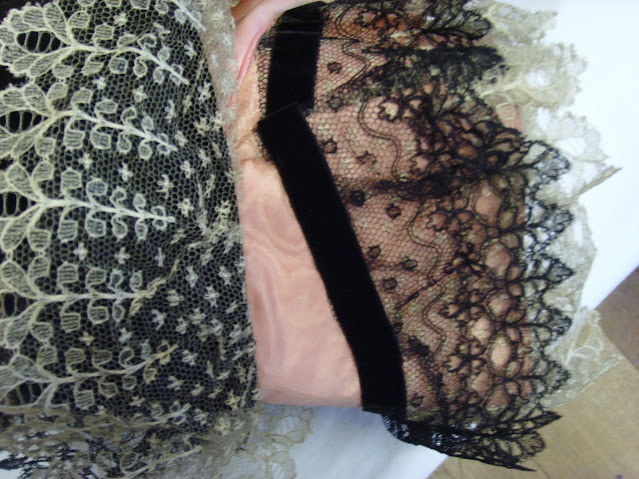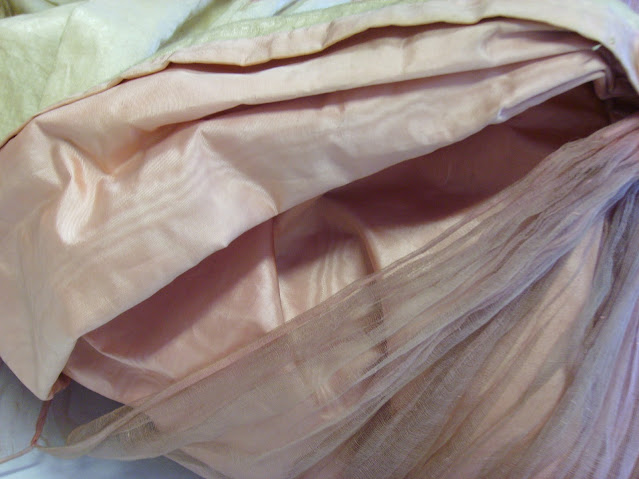Extant 1860's Evening Gown Bodice Details
Hello! It's that time of year again - the Prior Attire Victorian Ball is coming up fast, and we're all sewing frantically... well, I'm not because I don't have the energy, but I will be updating last years' dress to fit with the 'new' fashions of 1850-68.
The Fashion Museum Bath recently posted a beautiful pink and black dress on their social media channels, and I remembered that I had studied that dress up close on a research visit. So here are my photos of BATMC 1.09.1308 (A&B I think).
She's a separate bodice and skirt dated 1860-69, made of silk in moiré and velvet, plus lace trim.
The sleeves are formed of an inner, fitting short sleeve and a fuller outer sleeve. The inner sleeve has a small amount of gathered tulle trim at the hem, while the outer sleeve has two layers of lace with a strip of velvet ribbon covering the raw edges where they are attached to the main fabric. The inner sleeve is lined and the hem is finished with a row of piping. The outer sleeve is unlined and is finished with a narrow rolled hem.
The bertha collar is handstitched in place at the neckline after the bodice is complete. It is open at the centre back to allow for fastening. Both the top and undersides are velvet. There is a seam at the centre front, and the decorative knot is stitched on top of it. The black lace is stitched onto the outside and the ivory/white to the inside. There is a narrow black lace edging along the top front of the bertha.
The bodice is underlined (probably in cotton). I didn't make a note of whether or not the seams are machine stitched, but certainly they are hand-finished with overcasting, topstitching, and application of boning tape. The neck, waist, armscye and inner sleeve hems are finished with a single row of piping. The side back seams are topstitched to make a decorative faux flat piping look. The front and side seams are left plain. There are two hooks at each side to attach the bodice to the skirt. The back is spiral laced, with hand stitched eyelets. There are hooks and eyes on the inside at both top (neckline) and bottom (waist) of the lacing, for stability. The bodice is lightly boned, with three bones placed along the length of each front seam and one along each centre back edge. I don't know if the side seams are boned. It is comprised of eight panels: 2 x centre fronts, side fronts, side backs, and centre backs. There is a narrow lace trim stitched just inside the neckline.
The skirt is made up of a moiré underskirt with tulle overlay. Each layer has its own waistband, which are then stitched together in places. The moiré underskirt is underlined in glazed cotton and has a wide tulle frill at the hem. Excess fabric is folded towards the inside waist. Gauging (cartridge pleating) is used to distribute the fullness and the skirt is whipstitched onto its waistband. The tulle overskirt has two widths of decorative velvet ribbon stripes applied towards the hem, supported from the wrong side of the tulle by net fabric. The tulle is gathered onto a grosgrain ribbon waistband. Metal eyes are stitched to the waistbands (together) to correspond with the hooks on the bodice. The waist fastens with a large hook and eye.
The bodice:

The wrong side of the moiré underskirt hem, showing the glazed cotton underlining.
The moiré is so lustrous!
That's all for now, I'm going back to my little bit of sewing... Fingers crossed it'll be finished well before the ball... but how often does that happen, really?! Hehe :D

























❤️
ReplyDelete